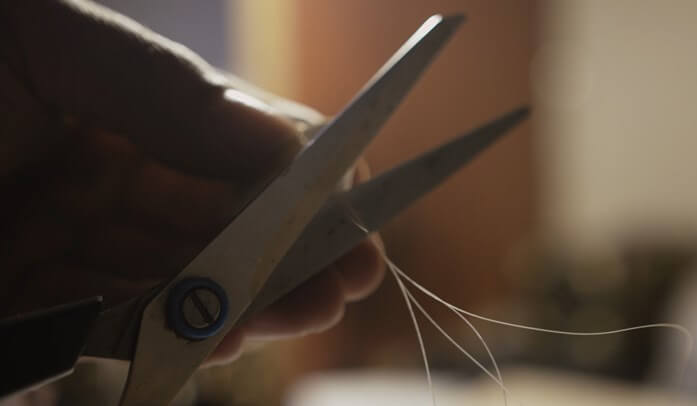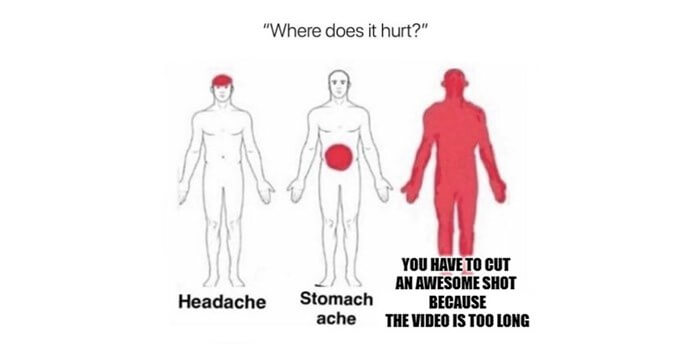Highlights
Table of Contents
Explore article topics
Did you ever stop to think about all the filmmaking terms we use nowadays that harken back to the good ol’ days when “films” were actually shot on film? (Uh, wait. They’re still shot on film. Back when they were only cut on film?) Terms like…
- “Reel” – as in “demo reel” today, but originally an actual reel of film.
- “Footage” – how long in feet the film reel was.
- “B-roll” – an actual roll of film edited together that was footage secondary to the primary footage (A-roll). B-roll nowadays refers to the footage you see playing over some other dialog or voiceover. The most common place you see it is in news programs (e.g., shots of a crime scene while you hear the reporter talking about it). Beautiful stock footage can make great B-roll, and if you master the art of editing stock footage into your video, it will improve your video’s quality.
- “Clips” – physical clippings cut from film reels that were to be spliced together in the editing room.
- “Bins” – the section in traditional NLE software like Adobe Premiere where video clips are held. Originally, film clips were hung in bins during the editing process. (Final Cut Pro X abandoned “bins” in favor of “keywords” back in 2011.)
- “Cutting” – a nickname for “editing” that originated because film used to be edited by physically cutting a “workprint” into clips, then re-arranging and splicing them together.
It’s that last term, cutting, that I want to talk about today. There’s another reason it’s called “cutting.” And a good editor knows what it is.
Getting to the essence of the edit
In an article about the power of video, I recently read that the average attention span of a person nowadays is just 8 seconds (that’s one second less than the attention span of a goldfish). That means when a person comes to a website, you have (on average) just 8 seconds to capture their attention. For those of you who are producing web videos for clients, you need to be aware of this fact. This is true for whatever content you’re creating, whether for yourself or for YouTube, where attention span is not only short but also challenged by dozens of other videos clamoring to reclaim it.
I’ve always felt that a shorter video is generally more effective than a longer one. Why take 4 minutes to say that which can be effectively communicated in 2 minutes? Just so you can show more pretty shots? You run the risk of losing your audience before the video is finished.
I watched a promo video that was literally twice as long as it needed to be, and it felt like it dragged (the promo, not the event for which the promo was made).
One of the hardest things for a newbie film editor to do is cut their film down. Especially if they were the director too (which is most often the case among YouTubers, small business filmmakers and videographers). There are all those cool shots you just can’t stand to leave on the proverbial “cutting room floor,” so you keep them in. Or you have all these wonderful soundbites that are just too good not to put in the video, so you keep them all. But if you want to grow as a storyteller in this medium, one of the most important things you need to learn is the discipline of cutting out anything and everything that is not absolutely needed to contribute to the story (or communicate the message if it’s a commercial production).
There’s a reason they call it “cutting”

A good friend of mine, who is an Indie filmmaker, once told me a long time ago when I was just a filmmaking babe, “cut your films down to as short as you possibly can, then once you’ve done that, cut them down some more.” I always keep that advice in the back of my brain when I’m editing a project. I often have to whittle hours of footage down to just a few minutes. That means every shot, every soundbite, needs to be just right. The more “fat” left in a short film, the greater the chance of losing your audience. And in today’s world, with so much competition vying for people’s attention, each second counts.
Here are some tips from my experience.
- Every frame counts: I get so detailed in my cutting that I’ll shave off individual frames from some shots. Keep in mind that for most of my work, there are 24 frames in a second. So I’m literally saving off fractions of a second. But those fractions add up over a 4, 6 or 10-minute film.
- Don’t repeat: for many documentary-style projects (e.g., corporate video, event video, a feature or short film documentary, etc.), you may find yourself interviewing a series of people all talking about the same topic. Inevitably, they will all at some time make a similar or identical point. For the most part, I’ll use the best soundbite from just one of them as it relates to that one point. This is not a hard and fast rule. There may be times when you may want to include a particular aspect that every single person mentioned and string them together to make a stronger point.
- Aim for a specific length: it helps if you have a specific length of time to aim for. For a web promo, 2-2.5 minutes is ideal, with 4 minutes being tops (although, it had better be a very engaging and interesting promo if you’re going to make it 4 minutes long). Most broadcast TV commercials have to be exactly 29.5 seconds. In “Hollywood,” studios are always imposing strict run times. If you’re committed to a set time length, that will force you to make the hard choices to cut out what isn’t absolutely needed.
- Save longer versions along the way: in my process of cutting down the videos I edit, I’ll duplicate the sequences I create, then rename them with sequential numbers (e.g., promo pass dump, promo pass 1, promo pass 2, etc.) The “dump” sequence is the very first dump of all the footage and synchronized audio. Each subsequent pass is shorter than the last. If I ever need to go back to get a soundbite or visual I cut out previously, I just open it up and copy and paste the clip I need.
- Be mindful of the message: if you’re creating a commercial piece meant to communicate a message, always keep that message in mind.
- Split it up: sometimes, you can split a video into multiple parts if you feel that the information you have is too important to leave out, but adding it back in will make the piece too long. For some of my promo clients, I will almost always have a complementary shorter video with additional interview footage from their clients. (Note: that’s complimentary with an “e,” not an “i.”) Think of them as “special features.” It gives the viewer the option to dive deeper into a specific topic if they want while keeping the main promo short and tight.
- The human eye and ear are amazing: we can actually take in quite a bit of information in a relatively short amount of time. Use that to your advantage. Sometimes all you need is a split second to communicate a world of information.
Get unlimited high-quality music for your videos
Delivering a lot of information in little time
Take a look at this award-winning commercial for the “Got Milk” campaign. It’s only 60 seconds but look at everything you learn about this guy in that time. And pay attention to how quickly the shots go by after he hears the contest question.
In a world where the musical, “Hamilton” by Lin Manuel Miranda is a worldwide hit, this commercial is less funny. Part of the comedy in the original commercial was that not very many people would necessarily know that bit of American history. Now I’m sure everyone with access to a computer with an Internet connection knows. Nonetheless, the editing lesson still applies.
So the next time you’re editing a project, play a game. Whatever length you were initially planning to make it, cut it in half. Even if it’s just something you do aside from whatever you submit to a client. Practice cutting your films down, and when they are as short as they can be, cut them some more.
What a difference the “ums” make
Most of my work primarily consists of B-roll over dialog from interviews. One of the most effective ways to shorten an edit is to get rid of all the ums, pauses and tangential thoughts an interviewee gives. Usually, the more nervous a person is, the more of these they will have. So you want to make them as comfortable and at ease as possible during the interview itself. But even the most eloquent CEO can have several “ums,” “uhs” or other non-essential thoughts. You’d be surprised how much time you can shave off an edit when you painstakingly get rid of all these irrelevant soundbites. Not only can you shave quite a bit of time out, but your subject will be happy you made them sound more intelligent.
illustrate just how dramatic a difference it is when you extract all those “ums” from your video, I’ll use a short section of an interview from a promo I shot years ago. During that shoot, I interviewed 7 CEOs of medium to large companies. Here’s an audio excerpt from one of them. This first clip is the raw audio I started with for one section of the interview:
Now here’s that section of the interview again, this time with all the extraneous words removed:
As you can hear, it still sounds smooth. Just listening to it, you’d never guess she had as many ums and pauses as she did. And as you can see in the lower left-hand part of the player, I took that section from 22 seconds down to 14. That’s over 36%. Imagine doing that throughout an entire edit. If you did, you could easily turn a 4-minute video into a 2.5-minute video. And keep in mind that every frame counts. Two frames here, three frames there, another frame over there…they all add up over the course of the video.
Gut-wrenching sometimes, but necessary

There will come times when it may be gut-wrenching cutting out what you think is a really cool soundbite. One thing to keep in mind is that the person watching the video has not seen all the footage you’re watching and listening to. So, to them, it does not feel like anything is missing and everything is new. As the editor who has seen all the footage, you’re going to be more attached to it. There is no right or wrong answer to these kinds of decisions. But I think sharing my thought processes may help some of you when you’re in the editing room trying to decide what gets relegated to the proverbial “cutting room floor.”
Just remember that advice my Indie filmmaking friend gave me: when you’ve gone through an edit and cut out everything you think you can, go through it one more time and cut some more.
For nearly 20 years, Ron has been a professional video producer, content marketer, and influencer in the visual arts industry. Most recently was managing editor of the Frame.io blog and currently managing editor of Film Riot. He helps brands and creative artists tell their stories using video, content, and words. You can learn more about him at https://bladeronner.media.
Share this article
Did you find this article useful?
Related Posts
- By Josh Edwards
- 11 MIN READ
Latest Posts
- 25 Apr
- By Josh Edwards
- 4 MIN READ
